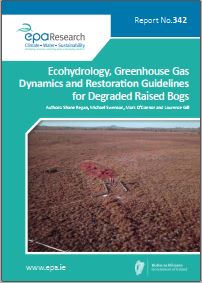Research 342: Ecohydrology, Greenhouse Gas Dynamics and Restoration Guidelines for Degraded Raised Bogs
Authors: Shane Regan, Michael Swenson, Mark O’Connor and Laurence Gill
Summary: This report presents the results of an integrated scientific study on two raised bogs, Clara Bog, Co Offaly and Abbeyleix Bog, Co Laois, which are considered to be representative of lowland peatland conditions encountered in Ireland. To assess the restoration potential of degraded raised bog systems, and the level of management required to address the degradation, a simplified set of guidelines is provided as a summary in this report.

Identifying Pressures
The range and function of raised bogs across Ireland and Europe has decreased greatly in the past few decades. This requires attention in the form of further advances in best practice management for remaining and degraded systems. Effective management therefore requires a quantification of the ecohydrological processes that create and maintain active bog and carbon sink conditions. Accordingly, the aim of this report was to:
- quantify the ecohydrological conditions and greenhouse gas (GHG) emissions from two contrasting raised bogs with different management histories;
- assess the impact of drainage and restoration on GHG emissions;
- assess the implications for management and the re-establishment of degraded peatlands to carbon sink ecosystems; and
- provide guidelines for the restoration of other degraded raised bogs.
The GHG results are consistent with international studies and show that the net ecosystem exchange of carbon dioxide (CO₂) in areas of active bog is in the order of −50 g C-CO₂ m⁻² year⁻¹ and switches to CO₂ emissions in the order of 100–300g C-CO₂ m⁻² year⁻¹ when drained. Upscaling fluxes using ecological mapping finds that even relatively intact bogs are sources of CO₂ to the atmosphere because of a limited distribution of Sphagnum species. The water table dynamic is the critical driver of GHG emissions and further confirms that peatland carbon and water cycling are strongly coupled. The export of dissolved organic carbon was also found to be a significant part of the bog carbon balance and as significant a pathway for carbon loss as the CO₂ land–atmosphere exchange.
Informing Policy
The development of ecotope CO₂ emission factors in this research finds that Natura 2000 sites in Ireland emit approximately 80% more CO₂ than they sequester. Raised bogs, and peatlands in Ireland generally, are therefore considered significant sources of CO₂ and must be accounted for in GHG land use inventory reporting. The value of bog restoration is thus not as much about creating a carbon sink as it is about preserving the peat carbon store and reducing emissions. It is important that peatland restoration and protection forms an integral part of a national climate adaptation and mitigation plan. Meeting conservation objectives of favourable conservation status for the Natura 2000 network is therefore entwined with land management climate mitigation strategies.
Developing Solutions
Engineering solutions required to restore the hydrological balance of degraded raised bogs, and their carbon sink function, can be costly if works are not focused in appropriate areas. Restoration must reinstate a functioning acrotelm and this study finds that the optimum topographic condition for this is having a slope gradient below 0.6%. Water losses can be compensated with greater proportions of lateral flow but it is difficult to engineer this situation in management. To maximise regeneration potential, restoration works must restore the surface water slopes (the hydraulic gradient) that ensure maximum water table depths of 0.2 m beneath the ground surface. The findings from this research suggest that, in some instances, particularly areas where peat rests on permeable subsoil, groundwater drainage is also an important drainage mechanism and in these scenarios a regional approach to ecohydrological restoration is necessary.
https://www.epa.ie/media/epa-2020/publications/research/Thumbnail_342.jpg